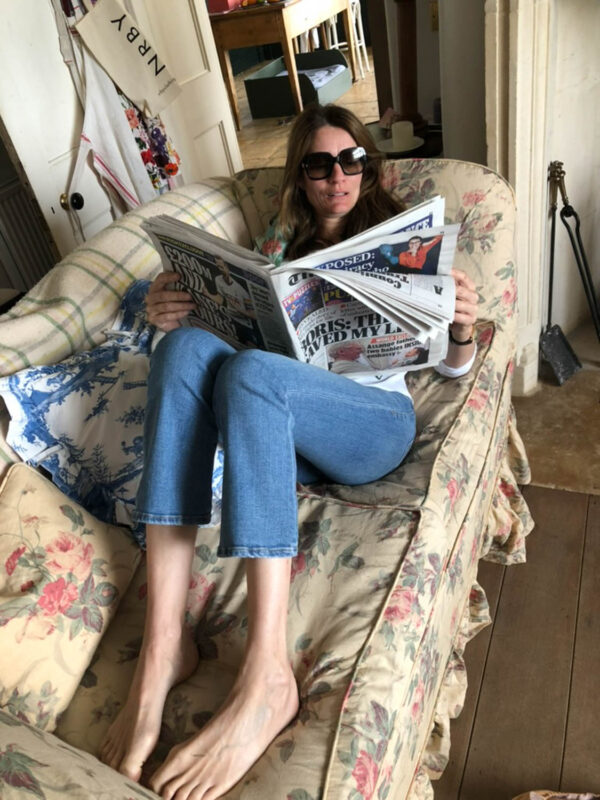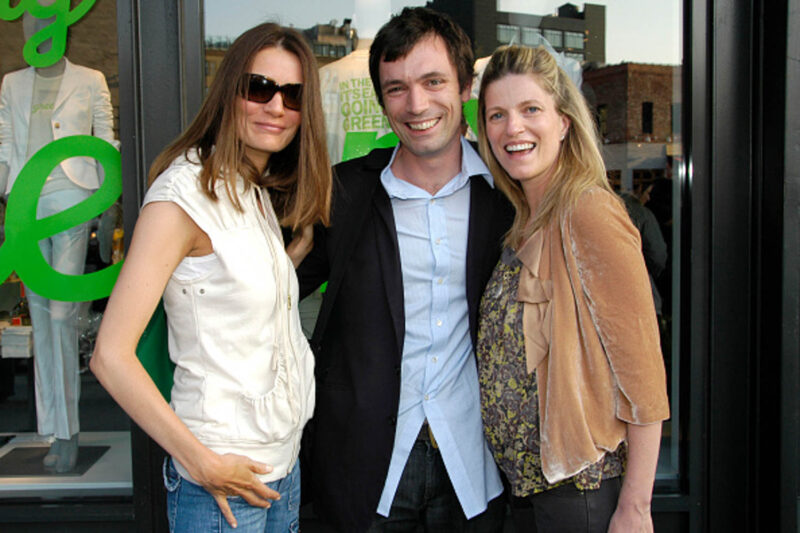
Gilded Page
Q&A with Plum Sykes
In her new book Wives Like Us, the Vogue contributor and Bergdorf Blondes author finds a rich (hedgerowed) field for her muse to play in: the stately homes of England.
From Brideshead Revisited to the updated black comedy Saltburn, we are obsessed with the world of grand estates and all the social intrigue that comes with them.
Now, after conquering Manhattan in Bergdorf Blondes, Plum Sykes brings us Wives Like Us, a chronicle of the monied set in the Cotswolds—as seen through the bemused eye of Ian, the perfect English butler (essentially a cross between Mary Poppins and a Hollywood fixer). Ian cleverly navigates the world of two rich English wives; one American divorcee; two tycoons; an Adonis in the shape of a stable boy; and a handsome, heroic farmer. Sykes’s world is the Venn diagram where P.G. Wodehouse meets WWD.
(I am very familiar with the part of the world Sykes writes about. While I moved back to the U.S. before much of the surge of new American wealth hit the Cotswolds, I remain extremely fond of the English countryside and the denizens therein.)
Plum Sykes is 15 minutes early for our meeting at Cecconi’s in the Nomad hotel. At 54, she’s got the glowy skin of a woman 15 years younger. Dressed in jeans and cropped leather jacket and scarf, she’s already tucking into avocado toast, salmon, and green tea by the time I arrive. Like everyone else who’s read the book, I start by immediately trying to guess who all the main characters are based on.
Daisy Prince: I’m dying to know, who did you base the grand dame of the book, Lady Caroline Backhouse on?
Plum Sykes [laughs]: I wanted a character who was representative of the old school Cotswold lot—because this book is about the new Cotswold lot and you know it’s a battle.
There was always this kind of country lady who everyone relies on, everyone loves. And maybe because the Queen was sort of at the end of her life, she was like the grandmother figure. I just remembered that my grandmother (who basically brought up me and my sister, Lucy, and all the rest of the family) had this very posh friend called Lady Backhouse.
The last time I saw Lady Backhouse I was probably 10 but I have an image of a woman in a very gracious house, with a voice that’s husky, brogues, and gray hair. They all go hunting with the Beaufort. I like those characters because I think they are comforting, sort of where you go for a cup of tea—metaphorically speaking.
DP: What about the “Queen of the Bottoms” Tata, the flamboyant ex-PR now married to a tycoon who runs around town in her gold Bentley, lives in Bottom Manor and rules the “Country Princesses”? Was that based on just one person?
PS: The Tata character was one of the starting places for the whole book. I was thinking there is this glamorous group of women who are based in London/New York/Paris/St. Tropez. And they have decided that the Cotswolds is their Hamptons and they’ve refashioned it to suit themselves.
It’s got all the social intensity of London, all the glamour, and all the luxuries. It’s not like where the real Lady Backhouse lives, which is rural and quiet which I like—it’s like the Hamptons. There are dinner parties every night. It’s all around the Tews, Stow-on-the-Wold, Charlbury, Chadlington.
When I was coming up with a fictional place I was thinking of the Tews because you’ve got little Tew, Great Tew, Dun Tew. Then I thought of the Bottoms because I thought it would be funny. Lots of villages in England just happen to be called Bottom.
How do I set a novel in that world, which has become a microcosm within England and the world, where suddenly everyone wants to be?
I started seeing it when Amanda Cutter Brooks landed, and she was very influential in this whole recreation of the Cotswolds because of her shop. People suddenly could imagine themselves there because of her Instagram. Then Marie-Chantal (of Greece) got an incredibly glamorous house that Jacques Grange did up. But it is like being in Paris, it’s not like being in the English Countryside. It has incredible modern art. It’s not Ziegler rugs and mahogany tables anymore.
An estate agent told me this other day that half of the people looking for off-market properties in that area are American and they’re looking at houses above £5 million. Harry Styles is trying to buy a house there, he offered it to a friend who said, “I don’t want Harry Styles buying my house, tell him to go away!” Really, really big time celebs who can get 100, 150 acres for £10 or £12 million which I don’t think you can get here.
DP: You certainly can’t get that much in the Hamptons. You can get one acre.



DP: You have brilliant expressions. I really hope to “rise magnificently to the occasion like a perfectly baked truffle soufflé”—rather than “someone who wobbles like a blancmange in crisis,” as you described. Another one I loved, “Bryan, 53, but looked 62 due to that common affliction (‘business-dinner bloat’).”
PS: The women in England look amazing because they stop drinking when they’re having babies. But men, particularly Englishmen, do not look after themselves. Now, they’ve gone from business dinner bloat to all being on Ozempic. Now they all look like Swizzle Sticks.
DP: And of course everyone wants an Ian, the modern day Mary Poppins.
PS: Mary Poppins! I’ve gotten Mary Poppins, Carson from Downton Abbey and Dr. Doolittle and Jeeves (as in Jeeves and Wooster). It’s like the original gang from Bergdorf Blondes 20 years later landed in the Cotswolds and took over. The idea of that little group of princesses who’d gone somewhere else. I just couldn’t believe no one else had written the book.
DP: You are good at writing social satire about that group and yet still staying friends with that group. Most social satirists tend to be ostracized after they write. We can go down the list starting with Truman Capote. He’s the maestro of the knife cut. But you don’t do damage like that.
PS: I think I’m not bitchy. All your writing is about you and how you see the world. I actually wish I was a nouveau riche lady in the Cotswolds swishing around in a great gold Bentley because I can see the aspiration and how fun it would be. I’m laughing with them rather than laughing at them. They are in on the joke as well. They are all savvy, these women, they know their lives are pretty absurd. We’re all on the same side, I’m not out to get anyone. You don’t think “Plum’s really got it in for these people.”
The other thing is I genuinely want my books to be a very positive emotional experience for the reader because I really do feel like the world is dire right now. It’s very toxic. And I don’t think that you want to go and read a book that’s toxic as well. So I’m working very, very hard to make a delicious soufflé of a book that takes you away.



DP: I created Digital Party in much the same vein.
PS: Let’s escape from inflation, healthcare, Donald Trump, Joe Biden. . .
DP: In writing about rich wives, it’s interesting you chose the butler, an outsider, as the way in.
PS: I was reading lots of Jeeves and Wooster at the time to cheer myself up so that is an inspiration. It’s quite technically structured so that you go from one point of view to the other. But mainly, it’s from the butler’s point of view, which, for the reader, we can relate to being the outsider looking in and it takes you into that world in a nice way.
And Ian, as the main character, can always sort of say, as an aside, “Aren’t these women silly, but I love them.” A Truman Capote would go, “Aren’t these women silly, and I hate them. And I’m jealous of them.” That’s not me. Writing it was like being in a bubble bath or something.



DP: You are so on point about the brands you feature. They must love this. Do you ever insert them or are you just writing about what you observe? I was obsessed with the Yagya equestrian onesie, although I never saw anything like that hunting with the Beaufort.
PS: There was a brand called Miasuki, which was on the Via Spiga in Milan but the brand folded so I had to change the brand to the Swedish brand Yagya. It looks like Loro Piana for riding. But Miasuki actually did the riding onesies and I remember seeing a friend of mine in the white onesie which she wore with a few diamond bracelets as well.
Speaking of the Beaufort—when I was out hunting one day, I had on one of my granny’s stock pins, and it was a pearl with a ring of diamonds around it on a gold stock pin. Someone said to me, “That is way too flashy.” It was the most unflashy thing, it had one pearl. They thought that you should just wear a plain gold stock pin. And that was it. And probably not real gold.
DP: Speaking of the Beaufort Hunt Country—which is located right next to Tetbury where King Charles’ Highgrove estate is located—what’s the feeling about the royal family, and Princes William and Harry in that area now?
PS: I never saw them out here. But I did once have the most brilliant day’s hunting across the Highgrove Estate. We were riding through such virgin grassland and I saw hedges were so beautiful. So I stopped and stood up on my horse taking pictures of (then) Prince Charles’ hedges because they were so immaculate. But that was the only time we went to the estate.
DP: I’m glad to hear he’s holding up his reputation as the horticultural genius he’s reputed to be. And who doesn’t love an immaculate hedge?

Hero photo of Plum Sykes by Robert Fairer



